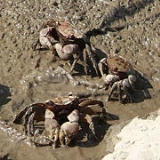
Chiromantes dehaani
Encyclopedia
Chiromantes dehaani is a mudflat crab
of the Sesarmidae
family (subfamily Sesarminae), which is endemic to East Asia
. It typically lives in mangrove
swamps and is known under the common name kurobenkeigani in Japan
. C. dehaani has an uneven carapace
, which is divided into four frontal lobes. Its walking legs are covered with thick, long seta
e (hairs), while the palm surfaces of its rough, granular chelipeds (claws) contain tubercules.
Crab
True crabs are decapod crustaceans of the infraorder Brachyura, which typically have a very short projecting "tail" , or where the reduced abdomen is entirely hidden under the thorax...
of the Sesarmidae
Sesarmidae
Sesarmidae is a family of crabs, previously included in the Grapsidae by many authors. Several species, namely in Geosesarma, Metopaulias and Sesarma, are true terrestrial crabs. They do not need to return to the sea even for breeding.-Genera:...
family (subfamily Sesarminae), which is endemic to East Asia
East Asia
East Asia or Eastern Asia is a subregion of Asia that can be defined in either geographical or cultural terms...
. It typically lives in mangrove
Mangrove
Mangroves are various kinds of trees up to medium height and shrubs that grow in saline coastal sediment habitats in the tropics and subtropics – mainly between latitudes N and S...
swamps and is known under the common name kurobenkeigani in Japan
Japan
Japan is an island nation in East Asia. Located in the Pacific Ocean, it lies to the east of the Sea of Japan, China, North Korea, South Korea and Russia, stretching from the Sea of Okhotsk in the north to the East China Sea and Taiwan in the south...
. C. dehaani has an uneven carapace
Carapace
A carapace is a dorsal section of the exoskeleton or shell in a number of animal groups, including arthropods such as crustaceans and arachnids, as well as vertebrates such as turtles and tortoises. In turtles and tortoises, the underside is called the plastron.-Crustaceans:In crustaceans, the...
, which is divided into four frontal lobes. Its walking legs are covered with thick, long seta
Seta
Seta is a biological term derived from the Latin word for "bristle". It refers to a number of different bristle- or hair-like structures on living organisms.-Animal setae:In zoology, most "setae" occur in invertebrates....
e (hairs), while the palm surfaces of its rough, granular chelipeds (claws) contain tubercules.

